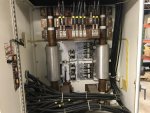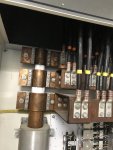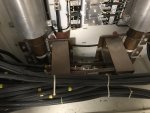rhamblin
Senior Member
- Location
- Kaukauna, Wisconsin
During a recent Infrared thermography scan of our plant, we came across some unusual readings from one of our main Switchgear units.
At our plant, we have a 24,900 volt phase to phase/14,400 volt phase to ground transformer dropping voltage down to 480V 3-phase. After this transformer, 11 conduits (parallel runs of 500 MCM) run into a Surge device cabinet.



From this Surge protective cabinet, another 11 parallel runs of 500 MCM feed to the 480 volt switchgear.
After finding the hot spot we decided to put a amp clamp on the hot wire, it was around 315 amps. So then we decided to measure a few of the other wires on the same phase. We couldn't check all of them because of the bundling of the wires. Here are some of the measurements that we encountered on these A phase parallel wires:
Now for my question, if all the wires are in parallel, shouldn't they have pretty close to identical resistances and therefore identical currents?
I don't think it would matter, but apparently the Surge protection devices in this panel, have been "burned out" since before I started 6 years ago. I'm looking for any information here. In my mind we have a lot of loose connections or bad crimps that is causing more current to be dispersed on some of the conductors.
At our plant, we have a 24,900 volt phase to phase/14,400 volt phase to ground transformer dropping voltage down to 480V 3-phase. After this transformer, 11 conduits (parallel runs of 500 MCM) run into a Surge device cabinet.



From this Surge protective cabinet, another 11 parallel runs of 500 MCM feed to the 480 volt switchgear.
After finding the hot spot we decided to put a amp clamp on the hot wire, it was around 315 amps. So then we decided to measure a few of the other wires on the same phase. We couldn't check all of them because of the bundling of the wires. Here are some of the measurements that we encountered on these A phase parallel wires:
- 165 amps
- 137 amps
- 69 amps
- 105 amps
- 138 amps
- 111 amps
Now for my question, if all the wires are in parallel, shouldn't they have pretty close to identical resistances and therefore identical currents?
I don't think it would matter, but apparently the Surge protection devices in this panel, have been "burned out" since before I started 6 years ago. I'm looking for any information here. In my mind we have a lot of loose connections or bad crimps that is causing more current to be dispersed on some of the conductors.

